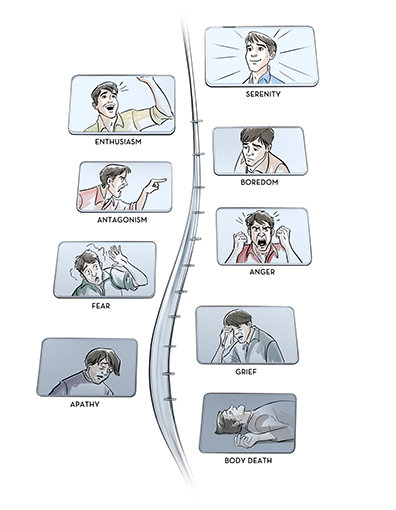The Emotional Tone Scale
The illustrated Tone Scale on this page shows you some of the most important tone levels that you will find in people. It goes from the emotional tone of serenity (a calm, peaceful state we can also call Happiness) at the very top down through Enthusiasm, Boredom, Antagonism, Anger, Fear, Grief and Apathy. Below that a person can be in the emotional tone of Body Death (he acts like he is actually dead or could actually be unconscious).
You can use the Tone Scale to spot the emotional tone level of people that you live and work with, as well as anyone you are in contact with at any time.
Being able to spot and know what tone level a person is in—either at that tone level for a brief period of time or always in that tone level—can help you predict how that person will behave when you communicate to him or interact with him.
Use this scale to learn how to quickly and accurately spot the tone level of people around you.

The Tone Scale And Understanding
The tones of the Emotional Tone Scale are very exact. Every person on Earth is somewhere on the Emotional Tone Scale and he moves up and down the scale following its exact pattern. People always come up or go down through these tones, one after the other.
The emotional tones are also called the tones of affinity. Affinity means love or liking, and it is used here as the idea of how much you like or dislike someone or something. You can easily see this if you take someone who is at the top of the scale. Someone in happiness has a lot of love or liking for other people. But a man in anger does not have much love or liking for anyone.
Going from the top to the bottom of the Tone Scale, a person moves through the following levels:
- Serentiy
- Enthusiasm
- Boredom
- Antagonism
- Anger
- Fear
- Grief
- Apathy
- Body Death

There are many small stops between these tones, but anyone knowing anything about people should definitely know these emotions.
When a person in apathy improves his tone, he feels grief.
When a person in grief improves his tone, he feels fear.
When a person in fear improves his tone, he feels anger.
When a person in anger improves his tone, he feels antagonism.
When a person in antagonism improves his tone, he feels boredom.
When a person in boredom improves his tone, he feels enthusiasm.
When a person in enthusiasm improves his tone, he feels serenity—or happiness.
People can be in any tone continuously over a long period of time—grief, fear, anger, antagonism, boredom or even enthusiasm.

Excerpted from The Scientology Handbook booklet: The Emotional Tone Scale by L. Ron Hubbard

